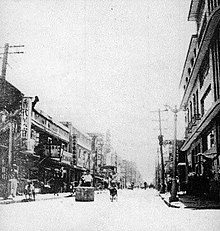Battle of Mudanjiang
| Battle of Mutanchiang | |||||||
|---|---|---|---|---|---|---|---|
| Part of the Soviet invasion of Manchuria of World War II | |||||||
 Ginza street in Mutanchiang, 1942 |
|||||||
|
|||||||
| Belligerents | |||||||
|
|
|
||||||
| Commanders and leaders | |||||||
|
K.A. Meretskov N.I. Krylov A.P. Beloborodov |
Seiichi Kita Shimizu Tsunenori |
||||||
| Units involved | |||||||
| Strength | |||||||
| ~290,000 soldiers 1,102 tanks and SP guns 4,790 artillery pieces |
55,000–60,000 soldiers ~104 artillery ~5 bombers |
||||||
| Casualties and losses | |||||||
|
Manpower 7,000–10,000+ casualties Materiel 300–600 tanks destroyed |
Manpower 25,000 total casualties including 9,391 killed Materiel 104 artillery pieces |
||||||
The Battle of Mutanchiang (or Mudanjiang) was a large-scale military engagement fought between the forces of the Union of Soviet Socialist Republics and the Empire of Japan from August 12 to 16, 1945, as part of the Soviet invasion of Manchuria in World War II. Due to the short nature of that campaign, this was one of the only set-piece battles that transpired before its conclusion. During the battle, elements of the Japanese Fifth Army attempted to delay the Soviet Fifth Army and First Red Banner Army long enough to allow the bulk of the Japanese forces to retreat to more defensible positions. Though casualties on both sides were heavy, the Red Army forces were able to break through the hastily organized Japanese defenses and capture the city ten days ahead of schedule. Nevertheless, the Japanese defenders at Mutanchiang achieved their goal of allowing the main forces to escape.
In February 1945 at the Yalta Conference, the Soviet Union under Joseph Stalin agreed to enter the war against Japan within three months' of Germany's defeat. In order to meet this deadline, it was necessary that the Soviet Union and Western allies cooperate in stockpiling supplies in the Far East while the Red Army dispatched additional forces along the Trans-Siberian Railway. While the Japanese monitored this buildup, they did not believe the Soviets would be ready to attack until mid-September, resulting in their being taken by surprise when the attack actually began on August 8.
The Japanese force tasked with defending Manchuria, the Kwantung Army, was by this time reduced from the IJA's premier fighting force to a shell of its former self. Having been stripped of most heavy equipment and experienced formations, its forces had an average efficiency of under 30 percent relative to prewar units. The Soviets, on the other hand, hand-picked their best formations from the war in Europe based on their experience against certain types of terrain and enemy defenses. Key to the defense of eastern Manchuria was General Seiichi Kita's First Area Army, based at Mutanchiang. Subordinate to this Area Army were the Japanese Fifth and Third Armies, of which the Fifth Army, led by Lieutenant General Noritsune Shimuzu, would play the main part in the coming battle. Overall strategy in the event of a Soviet attack was for an initial stand to be made near the borders, allowing the main Kwantung Army forces to withdraw to a "redoubt area" around the city of Tunghua. Unfortunately for the Japanese, neither the redeployments necessary for such a plan nor the fortifications at Tunghua were ready at the commencement of hostilities.
...
Wikipedia
